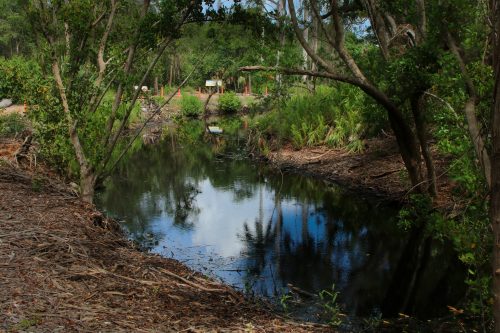Today at Pineland, there is no obvious drinking water source for people who thrived here for over 1500 years. The only obvious water bodies are brackish or salty, water not fit for drinking. So, where did the Calusa and their ancestors at Pineland get their freshwater?

The answer is beneath our feet. First, in places now altered by dynamic, ecological processes and obscured by human-driven land changes, artesian springs once percolated to the surface. Second, at least one spring-fed creek flowed to the estuary.
Evidence for the springs comes from excavations in several forms. In some, flowing water from buried springs flooded bottoms of trenches dug by archaeologists across the site. At others, where middens from past people were discovered below the current water table, pumps allowed excavation of ancient plant seeds, wood carving debris, and twisted palm fibers. A study of excavations where centuries old plant parts and pieces preserved, rather than rotted, as is typical, showed that a combination of at least two of three factors: elevation, age, and closeness to freshwater flow were required for survivability. And, freshwater from artesian sources was found to have been the key factor in preserving plant materials left behind at a time when overall drier conditions would have contributed to their decomposition.
Evidence for a western flowing creek, that crossed a southwestern section of the site as long ago as A.D. 250-300, includes 12 different wetland plant types identified from an excavation near Old Mound. In addition to the seeds of cypress, sedges, and sawgrass were preserved spores of freshwater algae and seeds of watershield along with remains of freshwater gar and shells of landsnails that must have been washed into the area. Other clues point to the creek flowing with more vigor during the wet summer period.
In oral histories associated with Pineland, Ted Smith recalled plentiful, clear, spring water near his family home in the early 1900s. The home was situated near Low Mound east of the Old Mound excavation. Traces of that spring and creek are indicated today by low areas filled with strap ferns and other wetland vegetation.
Other property across Pine Island’s vast estuarine shorelines also supported artesian springs. The presence of both percolating and flowing freshwater, however, made Pineland an ideal location for a large, permanent village.